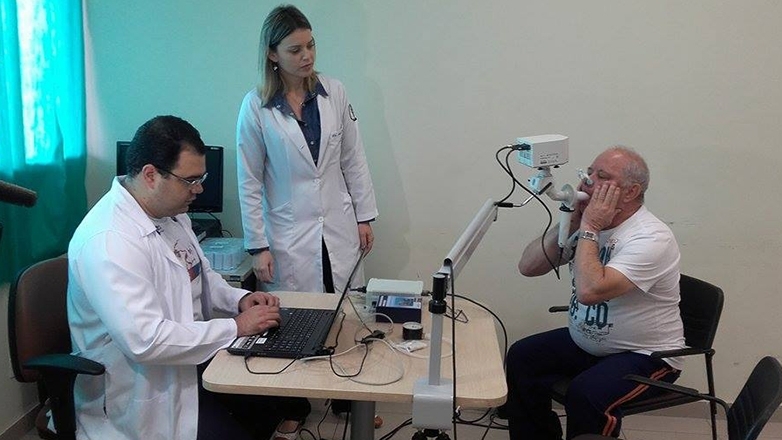

Results published in Scientific Reports by a research group at the Federal University of São Paulo help scientists understand why patients with metabolic syndrome are among those worst affected by COVID-19 (photo: City of São José dos Campos)
Results published in Scientific Reports by a research group at the Federal University of São Paulo help scientists understand why patients with metabolic syndrome are among those worst affected by COVID-19.
Results published in Scientific Reports by a research group at the Federal University of São Paulo help scientists understand why patients with metabolic syndrome are among those worst affected by COVID-19.

Results published in Scientific Reports by a research group at the Federal University of São Paulo help scientists understand why patients with metabolic syndrome are among those worst affected by COVID-19 (photo: City of São José dos Campos)
By Thais Szegö | Agência FAPESP – Abdominal obesity, high blood pressure, altered blood sugar or diabetes, high triglycerides, and low HDL (“good cholesterol”): people with at least three of these health problems suffer from a disorder known as metabolic syndrome. Its basis is resistance to the action of insulin, the hormone that regulates blood sugar levels so that the body’s cells can use glucose for energy and keep blood sugar within a healthy range. With insulin resistance, glucose cannot enter the cells as easily and it builds up in the bloodstream.
This hyperglycemia causes inflammation in the organism, triggering structural and functional changes in several organs, especially the heart, brain, kidneys and pancreas. Scientists have also confirmed that it impairs lung function and immune response. Chronic respiratory disorders are more frequent in individuals with severe obesity and metabolic syndrome. These complications are poorly understood, however, especially in older patients, and Maysa Alves Rodrigues Brandão Rangel, a physical therapist with a scholarship from FAPESP, decided to focus on them in her PhD research.
For the study, conducted by the Federal University of São Paulo (UNIFESP) in partnership with the City of São José dos Campos (São Paulo state, Brazil), 1,000 volunteers aged 60 or over were recruited from four rest homes in the city. Exclusion criteria included a history of smoking, a diagnosis of respiratory disease, chronic degenerative, auto-immune or neurological disorders, and regular physical activity. The remainder were divided into two groups of 77: one with metabolic syndrome and an average age of 68 (26 women and 51 men); and the other without metabolic syndrome and with an average age of 67 (56 women and 21 men).
All subjects were submitted to spirometry and impulse oscillometry, non-invasive methods used to evaluate lung function and respiratory mechanics, in the latter case by measuring sound waves superimposed on normal breathing. Overall muscle strength was measured by the handgrip method, and respiratory muscle strength using a pressure gauge. Blood samples were analyzed to measure cholesterol and triglycerides. Blood serum and breath condensate (collected for 10-15 minutes and then deep-frozen) were analyzed to detect the presence of pro- and anti-inflammatory cytokines, and pro- and anti-fibrotic factors (which promote or combat fibrosis).
The results, described in an article published in Scientific Reports, left no doubt that the inflammation induced by metabolic syndrome also affects the lungs, accelerating the inflammatory and fibrotic process. This was clear because the group with metabolic syndrome had higher levels of pro-inflammatory and pro-fibrotic factors in conjunction with lower levels of the substances that inhibit inflammation and fibrosis.
“Analysis of breath condensate showed that the inflammatory cytokines and pro-fibrotic growth factors found in the blood of these elderly subjects were also in their lungs,” Rangel said.
In addition, the data obtained by the researchers pointed to immune system alterations in the metabolic syndrome group, as well as significant deterioration of respiratory muscle strength, which is particularly important because people in this age group tend to have respiratory problems in general.
The mechanisms involved in the syndrome are now much clearer, and strategies can be developed to avoid complications. “It’s also evident that care of older patients should include detailed examination of their lungs and immune response, especially if they display symptoms of metabolic syndrome,” said Rodolfo de Paula Vieira, Rangel’s thesis advisor.
Finally, the results show why obese people with metabolic syndrome who already had mild inflammation were one of the groups that most suffered from COVID-19.
“The study showed that older patients with metabolic syndrome may also be more susceptible both to infection by SARS-CoV-2 and to development of the more severe forms of the disease since lung function and immune response are already impaired,” Rangel said.
The article “Pulmonary function changes in older adults with and without metabolic syndrome” is at: www.nature.com/articles/s41598-021-96766-x.
Republish
The Agency FAPESP licenses news via Creative Commons (CC-BY-NC-ND) so that they can be republished free of charge and in a simple way by other digital or printed vehicles. Agência FAPESP must be credited as the source of the content being republished and the name of the reporter (if any) must be attributed. Using the HMTL button below allows compliance with these rules, detailed in Digital Republishing Policy FAPESP.





